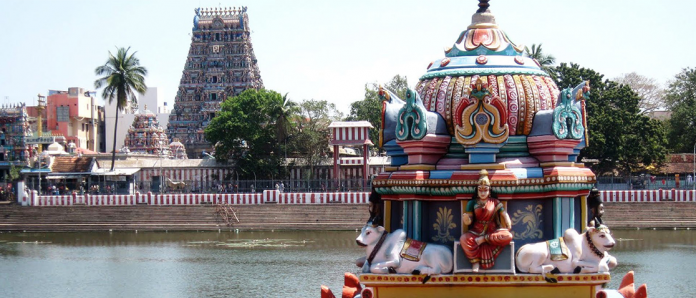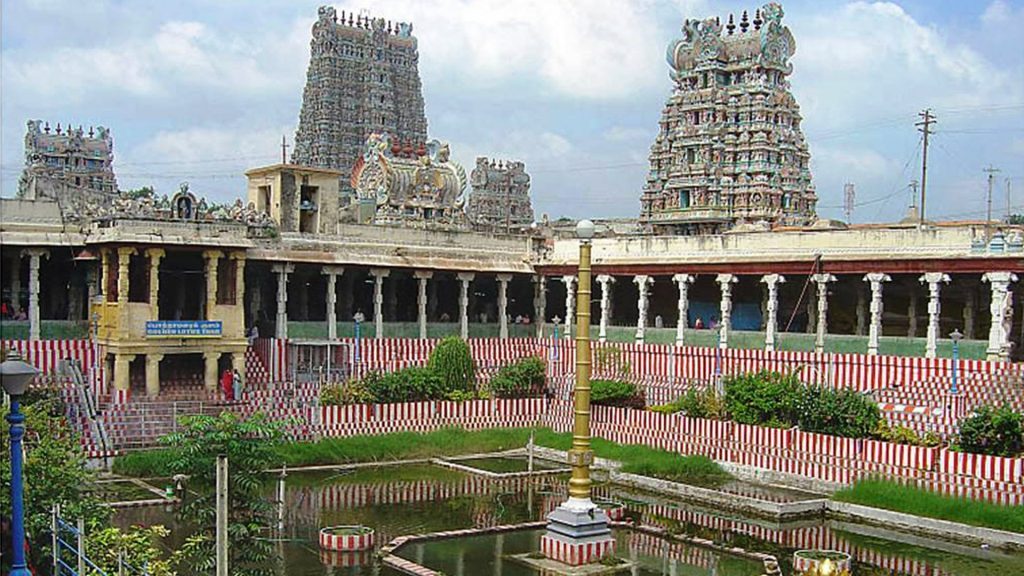Table of Contents
Kapaleeswarar Temple
History and faith lie entwined in the Kapaleeswarar Temple and its surrounds. The name of the locality, Mylapore, means ‘the abode of the peacocks’ and derives from the legend associated with the temple. Situated in the heart of Mylapore, at the centre of the four ‘mada veedhi’ (the surrounding streets where the procession of the deities takes place during festival days), the temple draws devotees on any given day of the week, particularly Mondays and Fridays. Mylapore’s landmark remains the Kapaleeswarar Temple and the theppakulam or the temple tank. A visit to this temple brings history, legends and myths together is an extraordinary religious experience.
Kapaleeswarar
The presiding deity in most Saivite temples is the lingam. Kapaleeswarar is a moderate-sized lingam crowned by a snake hood and its own base is usually swathed in a white veshti and rose garland. The idols of the 63 Nayanmar or Saivite saints stand along the walls outside Kapali’s sanctum facing west. On special festive occasions a bejewelled bronze idol of Kapaleeswarar with a majestic countenance is definitely brought out in procession. The altar of Karpagambal, Kapali’s consort, can be south of his sanctum. The 4ft-tall idol is certainly in standing posture, with four arms and an extraordinarily lovely face. On festival times the deity always decorated with floral silk skirts, a gold coin necklace, and huge diamond earrings in the shape of parrots. On Friday nights the bronze idol of the goddess is normally placed on a silver palanquin and carried around the temple thrice to the accompaniment of music and chantings of the Vedas.
Temple Legend
Once Shiva was expounding on the Panchakshara Mantra to Parvati, when the goddess’s attention wandered as she was captivated by the dance of a peacock nearby. An incensed Shiva cursed her to be born as a peacock on earth. Heeding a repentant Parvati’s request, he also granted her the boon that she would regain her original form and unite with Shiva when she completed her penance on the planet under a punnai (Indian laurel) tree. Another legend goes that once when Lord Brahma behaved arrogantly towards Shiva, the latter, in a fit of anger plucked off one of the heads of Brahma, thereby rendering him incapable of creating life. The ‘kapalam’ or skull of Brahma stuck to Shiva’s hand for a while. Later, Brahma repented his actions, did penance and regained his powers of creation. He hailed Shiva, as he had held his ‘kapalam’for a while, as Kapaleeswarar.
 Temple History
Temple History
The present temple is said to be only 300 years old, a baby as temples go in Tamil Nadu. But the idols are from a much older temple that stood on the seaside, a couple of kilometres away. The temple’s antiquity has been recorded by visitors across time. There are two versions about how the original temple was lost. One is that the sea rose and engulfed the temple. The other is that the Portuguese, who occupied Madras in 1566, demolished it. Devotees managed to save the idols and these were reinstated. Fragmentary inscriptions from the old temple can be found in the present one (much of the masonry and stones from the ruins of the aged temple were used in the construction of the new one) as well as in parts of St Thomas Cathedral in close by Santhome, built by the Portuguese.
#About Kapali Tank and Punnai Tree at Kapaleeswara Temple
Address:
Kapaleeswarar Temple,
Mylapore, Vadaku Mada Veethi,
Chennai – 600004.
Timings: 5 AM – 12 PM & 4 PM- 9.30 PM ; open on all days
Prasadam: Vibhuti and kumkum
Special Occasion: Arupathimoovar Festival (Mar)
Special Offering: Coconuts and flowers
Famous for: Compassionate deity for granting wishes

 Temple History
Temple History






![[Live] – Tirumala Darshan Crowd Status Today Tirumala Darshan Crowd Status Today](https://tirupatitirumalainfo.com/wp-content/uploads/2019/01/live-tirumala-darshan-waiting-time-100x70.png)










